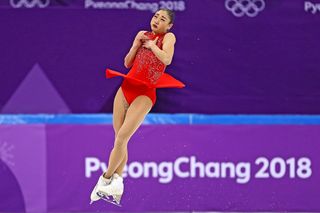
Can Olympic Figure Skaters Break the 5-Spin Barrier?

Olympic audiences went wild last week when Mirai Nagasu landed a triple axel, becoming the first U.S. female figure skater to turn an entire 3.5 rotations in the air at the Winter Games.
Meanwhile, male figure skaters have mastered the quadruple jump, that is, four rotations in the air. But no skater, male or female, has pulled off a quintuple-turn jump.
What gives? And more importantly, is it possible? [Photos: 6 Failed Winter Olympic Sports]
"I'm in the camp that I'm doubtful that that will happen," said Jim Richards, a professor of biomechanics in the Department of Kinesiology and Applied Physiology at the University of Delaware. But other human-biomechanics experts are more optimistic.
"I am a person who leans toward the 'yes' side," said Deborah King, a professor in the Department of Exercise and Sport Sciences at Ithaca College, in New York. Figure skaters could achieve a quintuple-turn jump if they perfected the key components involved in a rotation, she told Live Science.
When skaters leave the ice, they need angular momentum — that is, rotational energy that determines how fast and how much the skaters spin. Once they're in the air, they need to utilize that angular momentum by making themselves into a symmetrical, straight line — crossing their arms over their chests and crossing their legs and ankles — so that they can spin faster. By pulling in their arms, skaters bring their bodies' masses closer to the axis of rotation, something that causes the posh-sounding physics term "moment of inertia" to decrease. Essentially, the moment of inertia works against angular momentum (the spin). Result? The skater spins faster.
In addition, the time they spend in the air depends on their jump height. The higher they jump, the more time they'll have for revolutions before the anxiously awaited landing back on the ice, the experts said.
Sign up for the Live Science daily newsletter now
Get the world’s most fascinating discoveries delivered straight to your inbox.
In general, female skaters tend to jump between 15 inches and 20 inches (38 and 51 centimeters) and men usually jump between 20 inches and 23 inches (51 and 58 cm) vertically off the ice, Richards said.
Most skaters have perfected these components, King said. "They already have their limbs entirely plastered against the body, and they are as narrow as they could possibly get [during the jump]," she said. But some have room for improvement; their arms are crossed, but their elbows are sticking out, or their ankles are crossed, but their knees are separated an inch or two, she noted.
These athletes have "a couple inches of room to get tighter," King said. "From a physics standpoint, that's going to make them rotate a little bit faster."
Granted, the skaters would have to train themselves to get used to a faster rotation. Moreover, the faster they spin, the greater the centripetal force, which makes it feel like their arms are being pushed away from their body. "They have to use the muscles of their arms and legs to squeeze in tightly, and that actually takes a tremendous amount of strength, because they're going so fast," King said. [Winter Warriors: The Fitness Skills of 9 Olympic Sports]
If skaters can master the extra spinning and its increased forces, they could turn about an extra 100 degrees or 120 degrees, about an extra third of a 360-degree rotation, King said. So, to get closer to a full rotation, the skaters would have to train to jump even higher than usual — maybe another 2 inches (5 cm), which could give them another 60 degrees of rotation, King said. Even more practice could bring them to an extra 270 degrees, she said.
"That's three-quarters of a revolution," King said. "It's technically not a five-revolution jump. If they were doing it in competition, it would probably be downgraded because it's not totally rotated."
But it would still be an extraordinary feat, and it would be more than a 4.5-rotation, which has never been pulled off in a competition, she said. However, King noted that skaters would need the right body type — basically a small body that can spin quickly but that is also powerful enough to get a good jump height.
Richards agreed. It is possible that a five-rotation jump could be pulled off, if the right person trained enough, he said.
"It might be one person, but I don't see it happening on a wide scale," Richards told Live Science.
Original article on Live Science.

Laura is the archaeology and Life's Little Mysteries editor at Live Science. She also reports on general science, including paleontology. Her work has appeared in The New York Times, Scholastic, Popular Science and Spectrum, a site on autism research. She has won multiple awards from the Society of Professional Journalists and the Washington Newspaper Publishers Association for her reporting at a weekly newspaper near Seattle. Laura holds a bachelor's degree in English literature and psychology from Washington University in St. Louis and a master's degree in science writing from NYU.
